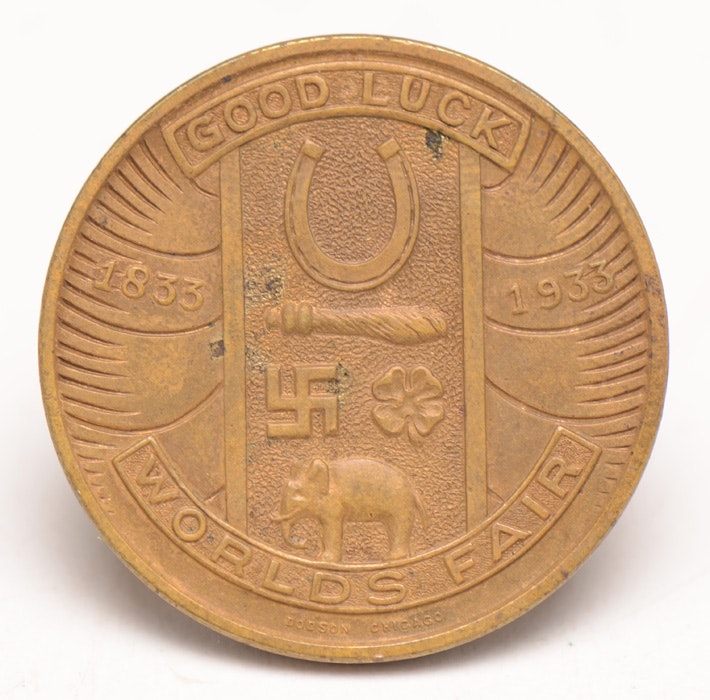Chicago's 1933 World's Fair: The Century Of Progress Exposition

Table of Contents
The Context of the Century of Progress Exposition
The 1933 World's Fair, or Century of Progress Exposition, emerged from the depths of the Great Depression. The nation was grappling with widespread unemployment, economic hardship, and a profound sense of uncertainty. Chicago, however, envisioned the fair not as a frivolous distraction, but as a bold initiative to reignite hope and stimulate economic recovery. The ambitious goal was to showcase the remarkable technological advancements of the era, projecting an image of progress and a brighter future for America. This was a daring undertaking given the prevailing economic climate; many questioned the feasibility of such a large-scale project during a time of such widespread hardship.
- Showcased the resilience and innovative spirit of Chicagoans. The very act of organizing and executing the fair demonstrated an unwavering belief in the city's potential and its people's ability to overcome adversity.
- Served as a symbol of hope and progress amidst economic hardship. For millions of visitors, the fair represented an escape from the harsh realities of the Depression, offering a glimpse of a more optimistic future filled with technological wonders.
- Attracted millions of visitors despite the depression. The fair's success in drawing such large crowds proved its power as a catalyst for both morale and economic activity.
Architectural Wonders and Technological Marvels of the 1933 World's Fair
The Century of Progress Exposition was defined by its stunning Art Deco architecture, a style that perfectly captured the era's blend of streamlined modernity and classical elegance. Buildings were characterized by geometric shapes, sleek lines, and a futuristic aesthetic. The fair's design showcased a bold vision of the future, influencing architecture and design trends for decades to come.
Notable examples include the Hall of Science, a breathtaking display of scientific innovation, and the various corporate pavilions, such as the impressive General Motors exhibit which showcased the latest advancements in automotive technology.
- The Sky Ride: This iconic feature offered visitors breathtaking panoramic views of the entire fairgrounds, providing a unique perspective on the sprawling complex.
- The Hall of Science: This pavilion showcased cutting-edge scientific discoveries and technological advancements, inspiring future generations of scientists and engineers.
- Impressive displays of General Motors and other major corporations: These displays underscored the importance of technological innovation in shaping the future and the role of corporations in driving progress.
Cultural Impact and Legacy of the Century of Progress
The Century of Progress Exposition left an indelible mark on Chicago's cultural landscape and beyond. Its influence is evident in the city's architecture, particularly the enduring presence of Art Deco design. The fair also spurred significant urban development, leading to the creation of new parks, infrastructure improvements, and a renewed sense of civic pride.
The lasting legacy of the 1933 World's Fair extends far beyond its physical footprint. Its impact on art, design, and popular culture continues to be studied and analyzed. The fair served as a catalyst for technological innovation, inspiring future advancements in various fields.
- The fair's influence on Art Deco design in Chicago: The style remains a prominent feature of the city's architectural landscape, a direct reflection of the fair's aesthetic impact.
- The creation of new parks and infrastructure in the city: The fair spurred significant improvements to Chicago's urban infrastructure, enhancing its livability and beauty.
- The ongoing interest and study of the fair's history and impact: The Century of Progress Exposition remains a subject of fascination and academic research, highlighting its enduring significance.
Conclusion
The Chicago World's Fair of 1933, also known as the Century of Progress Exposition, stands as a testament to human ingenuity and resilience. Despite the challenges of the Great Depression, this remarkable event showcased technological marvels, architectural brilliance, and a spirit of optimism that continues to inspire. Its legacy is woven into the fabric of Chicago, leaving an enduring mark on its urban landscape and cultural identity.
Learn more about the fascinating history and enduring impact of Chicago's 1933 World's Fair – The Century of Progress Exposition. Explore further to uncover the hidden gems and lasting contributions of this monumental event. Delve deeper into the archives and rediscover the wonders of A Century of Progress.

Featured Posts
-
 Amorims Man Utd Choice Leaves Garnacho Out In The Cold Liverpool A Potential Landing Spot
May 28, 2025
Amorims Man Utd Choice Leaves Garnacho Out In The Cold Liverpool A Potential Landing Spot
May 28, 2025 -
 Gyoekeres Atigazolas Az Arsenalhoz Minden Amit Tudni Kell
May 28, 2025
Gyoekeres Atigazolas Az Arsenalhoz Minden Amit Tudni Kell
May 28, 2025 -
 Decoding Taylor Swifts Easter Eggs Ama Reveal On May 26th
May 28, 2025
Decoding Taylor Swifts Easter Eggs Ama Reveal On May 26th
May 28, 2025 -
 The Phoenician Scheme Wes Andersons Cannes Entry Review And Commentary
May 28, 2025
The Phoenician Scheme Wes Andersons Cannes Entry Review And Commentary
May 28, 2025 -
 Jannik Sinner Doping Case Serena Williams Weighs In With Harsh Criticism
May 28, 2025
Jannik Sinner Doping Case Serena Williams Weighs In With Harsh Criticism
May 28, 2025
Latest Posts
-
 Miley Cyrus Openness About Her Fathers Narcissism A Powerful Story
May 31, 2025
Miley Cyrus Openness About Her Fathers Narcissism A Powerful Story
May 31, 2025 -
 Tuerkiye Macaristan Iliskilerinde Yeni Bir Doenem Haciosmanoglu Nun Ziyaretinin Etkisi
May 31, 2025
Tuerkiye Macaristan Iliskilerinde Yeni Bir Doenem Haciosmanoglu Nun Ziyaretinin Etkisi
May 31, 2025 -
 Apakah Selena Gomez Dan Miley Cyrus Benar Benar Akhiri Perseteruan Mereka Kencan Ganda Jadi Jawabannya
May 31, 2025
Apakah Selena Gomez Dan Miley Cyrus Benar Benar Akhiri Perseteruan Mereka Kencan Ganda Jadi Jawabannya
May 31, 2025 -
 Flowers Nowy Singiel Miley Cyrus Data Premiery Nowego Albumu
May 31, 2025
Flowers Nowy Singiel Miley Cyrus Data Premiery Nowego Albumu
May 31, 2025 -
 Haciosmanoglu Nun Macaristan Yolculugu Program Ve Etkinlikler
May 31, 2025
Haciosmanoglu Nun Macaristan Yolculugu Program Ve Etkinlikler
May 31, 2025
